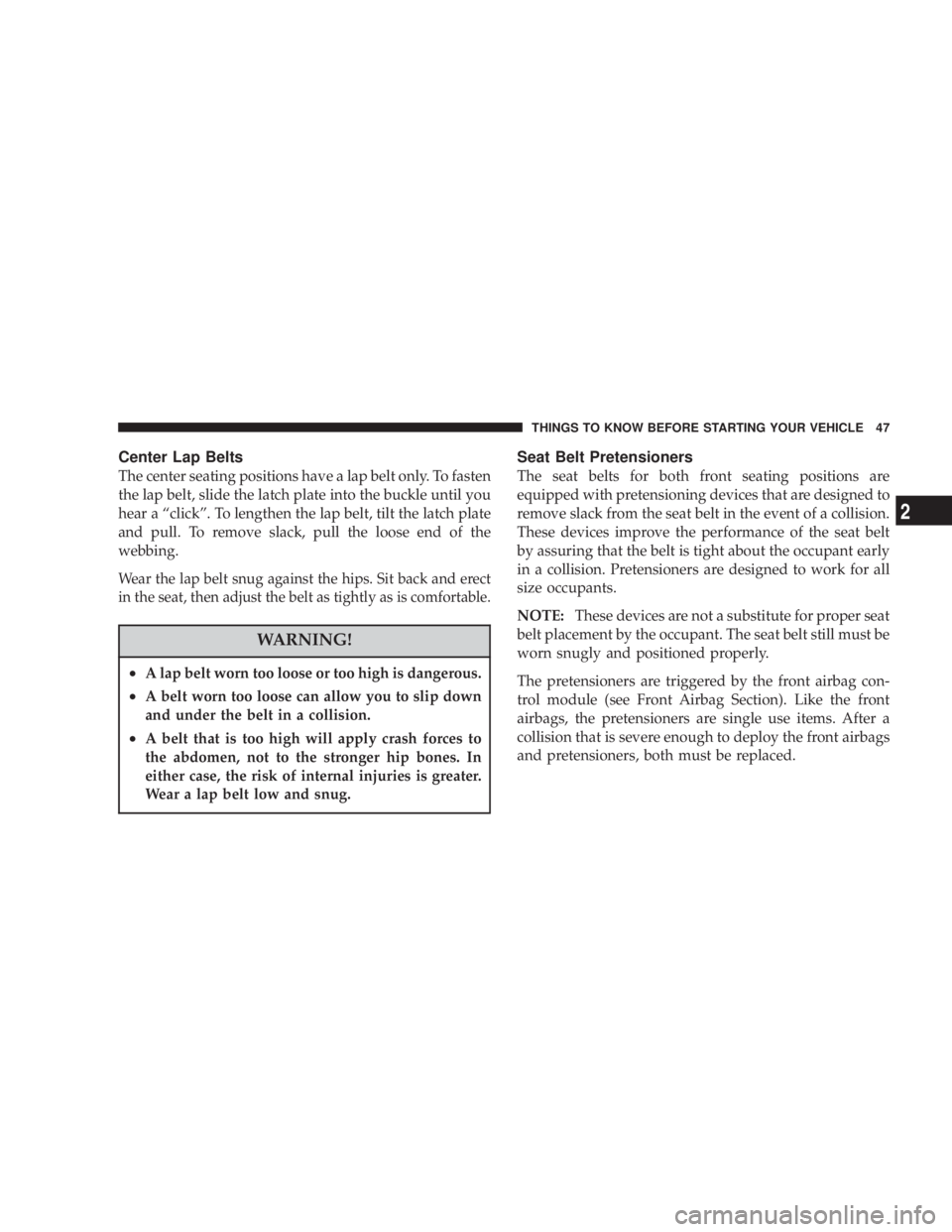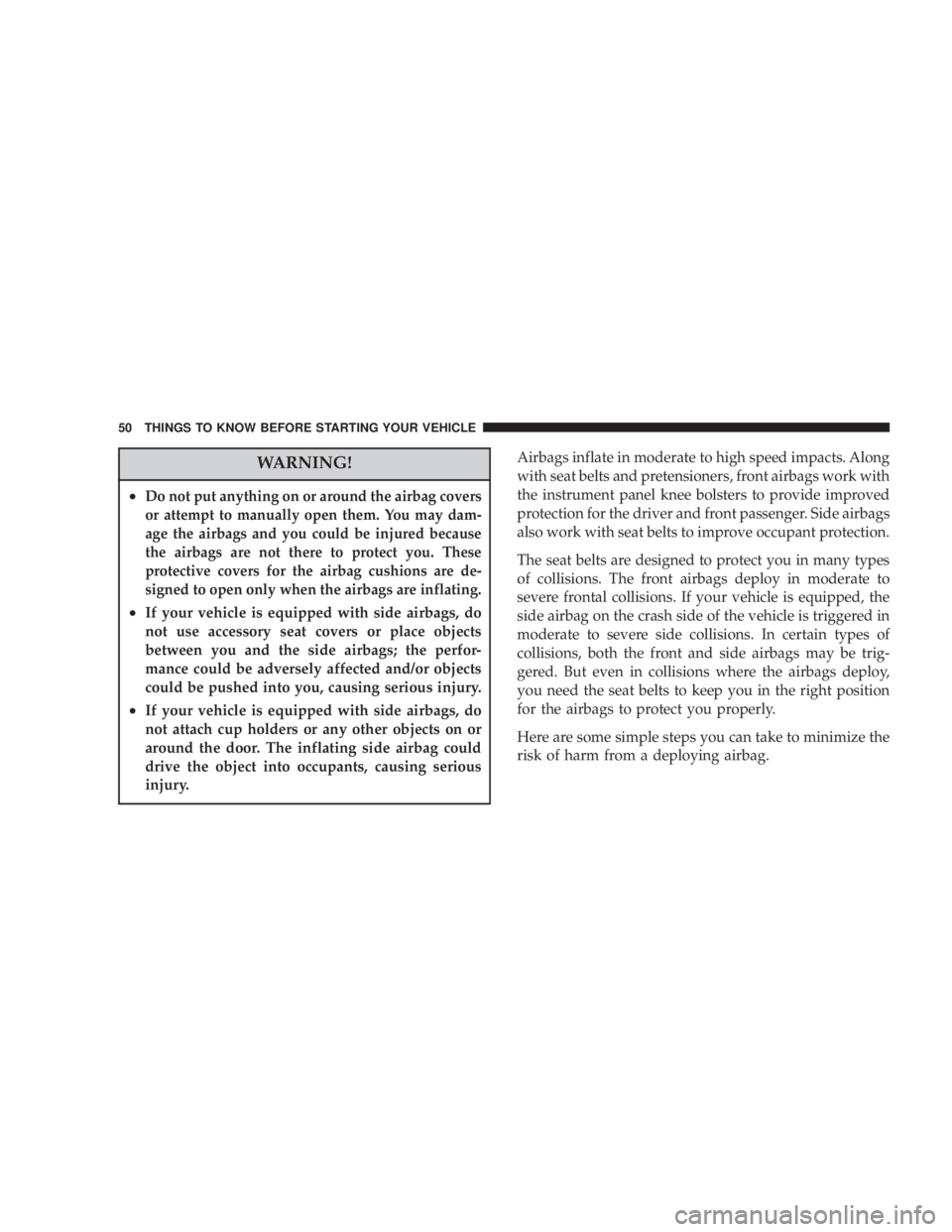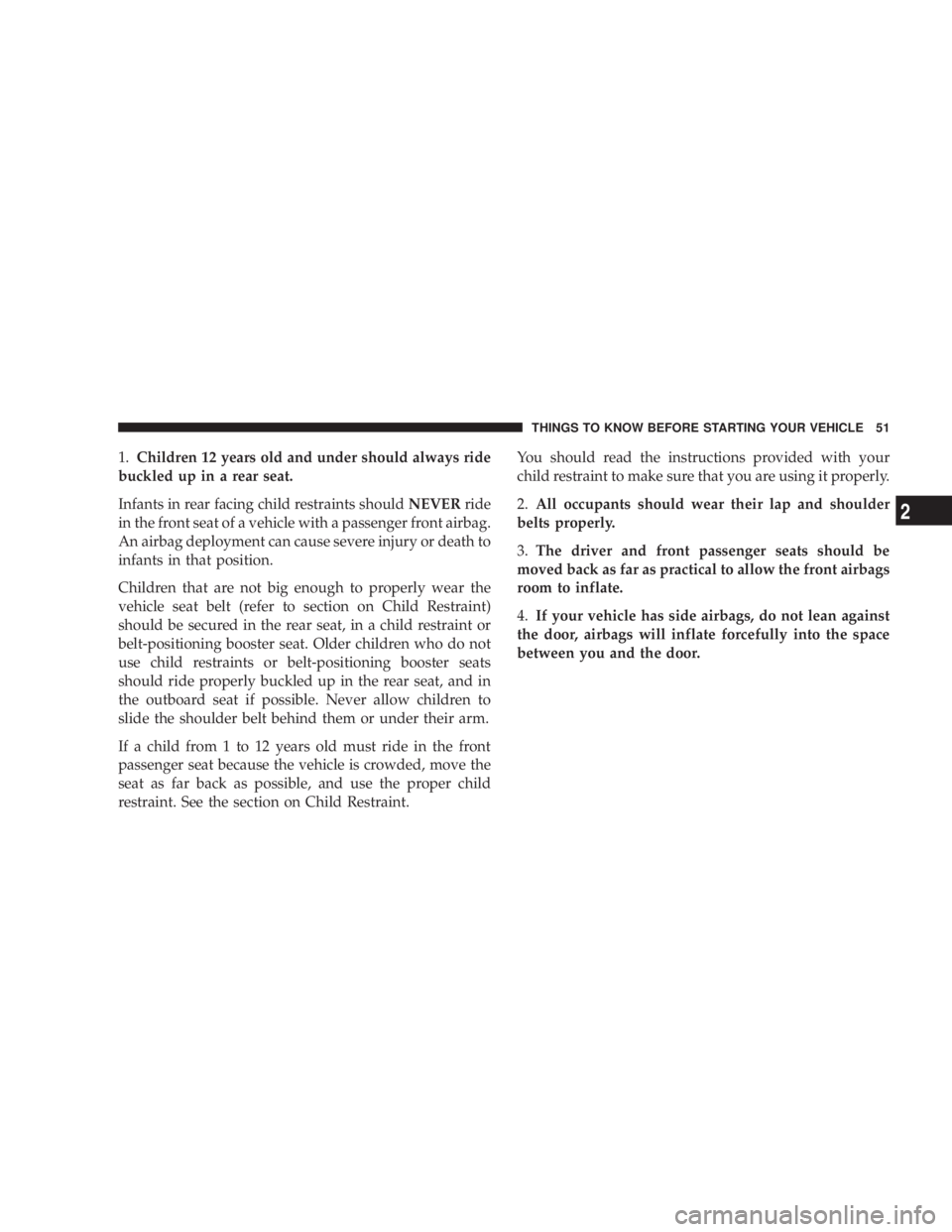Page 45 of 397
As a guide, if you are shorter than average, you will
prefer a lower position, and if you are taller than average,
you'll prefer a higher position. When you release the
anchorage, try to move it up or down to make sure that
it is locked in position.
Lap/Shoulder Belt Untwisting Procedure
Use the following procedure to untwist a twisted lap/
shoulder belt.
1. Position the latch plate as close as possible to the
anchor point. THINGS TO KNOW BEFORE STARTING YOUR VEHICLE 45
2
Page 46 of 397
2. At about 6 to 12 inches (15 to 30 cm) above the latch
plate, grasp and twist the belt webbing 180É to create a
fold that begins immediately above the latch plate.
3. Slide the latch plate upward over the folded webbing.
The folded webbing must enter the slot at the top of the
latch plate. 4. Continue to slide the latch plate up until it clears the
folded webbing.46 THINGS TO KNOW BEFORE STARTING YOUR VEHICLE
Page 47 of 397

Center Lap Belts
The center seating positions have a lap belt only. To fasten
the lap belt, slide the latch plate into the buckle until you
hear a ªclickº. To lengthen the lap belt, tilt the latch plate
and pull. To remove slack, pull the loose end of the
webbing.
Wear the lap belt snug against the hips. Sit back and erect
in the seat, then adjust the belt as tightly as is comfortable.
WARNING!² A lap belt worn too loose or too high is dangerous.
² A belt worn too loose can allow you to slip down
and under the belt in a collision.
² A belt that is too high will apply crash forces to
the abdomen, not to the stronger hip bones. In
either case, the risk of internal injuries is greater.
Wear a lap belt low and snug. Seat Belt Pretensioners
The seat belts for both front seating positions are
equipped with pretensioning devices that are designed to
remove slack from the seat belt in the event of a collision.
These devices improve the performance of the seat belt
by assuring that the belt is tight about the occupant early
in a collision. Pretensioners are designed to work for all
size occupants.
NOTE: These devices are not a substitute for proper seat
belt placement by the occupant. The seat belt still must be
worn snugly and positioned properly.
The pretensioners are triggered by the front airbag con-
trol module (see Front Airbag Section). Like the front
airbags, the pretensioners are single use items. After a
collision that is severe enough to deploy the front airbags
and pretensioners, both must be replaced. THINGS TO KNOW BEFORE STARTING YOUR VEHICLE 47
2
Page 48 of 397

Seat Belts and Pregnant Women
We recommend that pregnant women use the seat belts
throughout their pregnancies. Keeping the mother safe is
the best way to keep the baby safe.
Pregnant women should wear the lap part of the belt
across the thighs and as snug across the hips as possible.
Keep the belt low so that it does not come across the
abdomen. That way the strong bones of the hips will take
the force if there is a collision.
Seat Belt Extender
If a seat belt is too short, even when fully extended and
when the adjustable upper shoulder belt anchorage (if
equipped) is in its lowest position, your dealer can
provide you with a seat belt extender. This extender
should be used only if the existing belt is not long
enough. When it is not required, remove the extender
and stow it. WARNING!Using a seat belt extender when not needed can
increase the risk of injury in a collision. Only use
when the lap belt is not long enough when it is worn
low and snug, and in the recommended seating
positions. Remove and store the extender when not
needed.
Driver and Front Passenger Supplemental
Restraint System - Airbag
This vehicle has airbags for both the driver and front
passenger as a supplement to the seat belt restraint
systems. The driver's front airbag is mounted in the
center of the steering wheel. The passenger's front airbag
is mounted in the instrument panel, above the glove
compartment. The words SRS AIRBAG are embossed on
the airbag covers.48 THINGS TO KNOW BEFORE STARTING YOUR VEHICLE
Page 50 of 397

WARNING!² Do not put anything on or around the airbag covers
or attempt to manually open them. You may dam-
age the airbags and you could be injured because
the airbags are not there to protect you. These
protective covers for the airbag cushions are de-
signed to open only when the airbags are inflating.
² If your vehicle is equipped with side airbags, do
not use accessory seat covers or place objects
between you and the side airbags; the perfor-
mance could be adversely affected and/or objects
could be pushed into you, causing serious injury.
² If your vehicle is equipped with side airbags, do
not attach cup holders or any other objects on or
around the door. The inflating side airbag could
drive the object into occupants, causing serious
injury. Airbags inflate in moderate to high speed impacts. Along
with seat belts and pretensioners, front airbags work with
the instrument panel knee bolsters to provide improved
protection for the driver and front passenger. Side airbags
also work with seat belts to improve occupant protection.
The seat belts are designed to protect you in many types
of collisions. The front airbags deploy in moderate to
severe frontal collisions. If your vehicle is equipped, the
side airbag on the crash side of the vehicle is triggered in
moderate to severe side collisions. In certain types of
collisions, both the front and side airbags may be trig-
gered. But even in collisions where the airbags deploy,
you need the seat belts to keep you in the right position
for the airbags to protect you properly.
Here are some simple steps you can take to minimize the
risk of harm from a deploying airbag.50 THINGS TO KNOW BEFORE STARTING YOUR VEHICLE
Page 51 of 397

1. Children 12 years old and under should always ride
buckled up in a rear seat.
Infants in rear facing child restraints should NEVER ride
in the front seat of a vehicle with a passenger front airbag.
An airbag deployment can cause severe injury or death to
infants in that position.
Children that are not big enough to properly wear the
vehicle seat belt (refer to section on Child Restraint)
should be secured in the rear seat, in a child restraint or
belt-positioning booster seat. Older children who do not
use child restraints or belt-positioning booster seats
should ride properly buckled up in the rear seat, and in
the outboard seat if possible. Never allow children to
slide the shoulder belt behind them or under their arm.
If a child from 1 to 12 years old must ride in the front
passenger seat because the vehicle is crowded, move the
seat as far back as possible, and use the proper child
restraint. See the section on Child Restraint. You should read the instructions provided with your
child restraint to make sure that you are using it properly.
2. All occupants should wear their lap and shoulder
belts properly.
3. The driver and front passenger seats should be
moved back as far as practical to allow the front airbags
room to inflate.
4. If your vehicle has side airbags, do not lean against
the door, airbags will inflate forcefully into the space
between you and the door. THINGS TO KNOW BEFORE STARTING YOUR VEHICLE 51
2
Page 52 of 397

WARNING!² Relying on the airbags alone could lead to more
severe injuries in a collision. The airbags work
with your seat belt to restrain you properly. In
some collisions the airbags won't deploy at all.
Always wear your seat belts even though you
have airbags.
² Being too close to the steering wheel or instru-
ment panel during front airbag deployment could
cause serious injury. Airbags need room to inflate.
Sit back, comfortably extending your arms to
reach the steering wheel or instrument panel.
² If the vehicle has side airbags, they also need
room to inflate. Do not lean against the door. Sit
upright in the center of the seat. The Front Airbag System consists of the following:
² Front Airbag Control Module (with integrated side
impact sensor - if equipped)
² AIRBAG Readiness Light
² Driver Airbag
² Front Passenger Airbag
² Steering Wheel and Column
² Instrument Panel
² Seat Belt Readiness Light
² Front Seat Belt Pretensioners
² Interconnecting Wiring
² Knee Impact Bolster52 THINGS TO KNOW BEFORE STARTING YOUR VEHICLE
Page 56 of 397

haven't healed significantly within a few days, or if
you have any blistering, see your doctor immediately.
² As the airbags deflate you may see some smoke-like
particles. The particles are a normal by-product of the
process that generates the nontoxic gas used for airbag
inflation. These airborne particles may irritate the skin,
eyes, nose, or throat. If you have skin or eye irritation,
rinse the area with cool water. For nose or throat
irritation, move to fresh air. If the irritation continues,
see your doctor. If these particles settle on your
clothing, follow the garment manufacturer's instruc-
tions for cleaning.
² It is not advisable to drive your vehicle after the
airbags have deployed. If you are involved in another
collision, the airbags and seat belt pretensioners will
not be in place to protect you. WARNING!Deployed airbags and seat belt pretensioners cannot
protect you in another collision. Have the airbags
and seat belt pretensioners replaced by an autho-
rized dealer as soon as possible.
Enhanced Accident Response
If the airbags and seat belt pertensioners deploy after an
impact and the electrical system remains functional,
vehicles equipped with power door locks will unlock
automatically. In addition, approximately 10 seconds
after the vehicle has stopped moving, the interior lights
will illuminate until the ignition switch is turned off.56 THINGS TO KNOW BEFORE STARTING YOUR VEHICLE